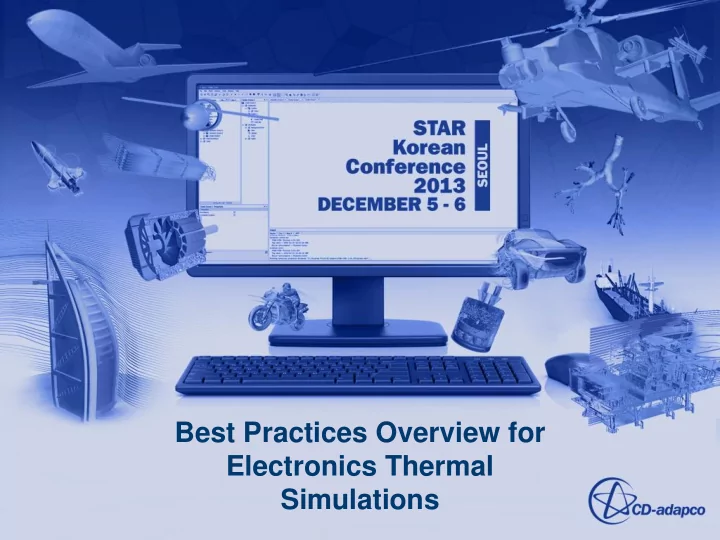

Best Practices Overview for Electronics Thermal Simulations
STAR-CCM+ Simulation Process Geometry Preparation Results Mesh Solution Materials Conditions
STAR-CCM+ Electronics Thermal Seminars http://www.cd-adapco.com/webcasts (Industry = Electronics) Natural convection series Forced convection series – Best practices – Best practices, part 1 – Small internal air gaps – Best practices, part 2 – Radiation – Complex heat sinks – Geometry preparation
STAR-CCM+ Template Simulation File • Assumes 3D- CAD → Parts → Regions Geometry • Composite parts Mesh • Pre-defined parts-based mesh (PBM) operations • Air (ideal gas or Boussinesq) Materials • Solids (common in electronics) • Pre-defined boundaries Conditions • Forced & natural convection • Field functions for ambient temperature & altitude • Segregated flow & energy with under-relaxation Solution • Gravity & radiation (natural convection) • Stopping criteria • Temperature report Results • Geometry & mesh scenes • Temperatures with velocity vectors on section planes
Best Practices: Geometry Preparation Solids – Eliminate mechanical connectors (screws, rivets, springs, etc.) – Fill holes – Simplify individual parts – Sheet metal modifications – Eliminate interferences – Fill undesired gaps
Best Practices: Geometry Preparation Air – Internal: Fill the empty space – External • Natural: Sphere or hemisphere • Forced: Short inlet, extended outlet – Tools (3D-CAD): Extract Internal / External Volume, Boolean
Best Practices: Geometry Preparation
Best Practices: Geometry Preparation
Best Practices: Meshing Ideally: Conformal polyhedral mesh – Strongly recommended for natural convection (because of radiation) – Good for forced convection Option: Polyhedral (conformal) air, trimmed (non-conformal) solids – Suitable for forced convection Part-Based vs Regions-Based – Preference – Conformal thin mesh not yet available with PBM Typical mesh: 500,000 – 5,000,000 cells
Best Practices: Meshing
Best Practices: Materials Air – Ideal gas with temperature- varying properties always suitable – Boussinesq sufficient for natural convection Solids – Isotropic solids – Orthotropic solids (e.g. PCBs) • Separate continua • Properties in the region • Typical PCB: k planar ~ 10 W/m-K, k through plane ~ 0.5 W/m-K – Components • Can use contact resistances on interface to model as 2-resistor. • Otherwise aluminum oxide (k ~ 25 W/m-K) common.
Best Practices: Conditions Heat sources – Temperature on all inlets & outlets – If no air surrounding the enclosure in the model (common in forced convection), to model heat loss to the ambient add convection on boundary: • External natural convection: h ~ 5 – 10 W/m 2 -K • External forced convection: h > 20 W/m 2 -K – Heat power on all dissipating components* Electrical power delivered Component Electrical (e.g. IC, IGBT, Heat power supplied MOSFET, LED,…) • “Wall power” RF energy, • Max power (power budget) • Measured power? visible light • Duty-cycled? • What is the efficiency?
Best Practices: Conditions FORCED Flow inlet Flow outlet CONVECTION • Specified positive flow speed • velocity), positive pressure, Pressure outlet (0 Pa) Flow “ pushed ” • positive mass flow rate, or Ambient temperature (for any into the system fan pressure jump reverse flow) • Ambient temperature • Specified negative flow speed velocity), negative pressure, Flow “ pulled ” • Stagnation inlet (0 Pa) negative mass flow rate, or through the • Ambient temperature fan pressure jump system • Ambient temperature (for any reverse flow) Fan inside the • Pressure outlet (0 Pa) • system: Stagnation inlet (0 Pa) • Ambient temperature (for any • Internal Ambient temperature reverse flow) Interface fan +
Best Practices: Conditions Internal Interface Fan – Only the circular or annular faces used as boundaries in fan definition – Flow direction: From Boundary-0 to Boundary-1 (Swap Boundaries on the interface as needed) – Fan curve • Define in the fan interface as a polynomial, OR • Input fan curve to Tools > Tables & then select the curve.
Best Practices: Conditions Natural Convection: Conditions on the exterior air boundary – Convection • Stagnation Inlet (0 Pa) • Total temperature = Ambient temperature – Radiation • Boundary transparency = 1.0 • Radiation temperature is specified in the air continua – Inside a room: Radiation temperature = wall temperature – Outdoors: Turn on solar if device exposed to the sun during the day, at night Radiation Temperature = sky radiation temperature
Best Practices: Solution Solvers > Segregated Energy Stopping Criteria – Fluid Under-Relaxation = 0.99 – Often convergence in 300 – 500 (default is 0.9) iterations. – Solid Under-Relaxation = 0.9999 – Observed residuals (non- (default is 0.99) normalized) • Energy residual < 1E-5 • Momentum residuals < 1E-8 – Convergence requires more iterations for a finer mesh. Scalability – For typical size scales well to ~8 cores. – I typically run with 2 or 4 cores.
Best Practices: Results
Best Practices: Results R thermal = (T center of base – T ambient ) Heat power Report (expression) from field functions: ($ThermocoupletemperatureReport - $Tambient_K)/$Heat_power
More Information: Web Seminar Recordings Natural Convection – Best practices: http://www.cd-adapco.com/webinar/electronics-best-practices-session-1- simulating-natural-convective-airflow-electronic – Small gaps: http://www.cd-adapco.com/webinar/electronics-best-practices-session-2-natural- convection-analyses-thin-air-gaps – Radiation: http://www.cd-adapco.com/webinar/electronics-best-practices-session-3-natural- convection-analyses-thermal-radiation Forced Convection – Best practices, part 1: http://www.cd-adapco.com/webinar/best-practices-forced-convection- simulations-series-1-part-1 – Best practices, part 2: http://www.cd-adapco.com/webinar/best-practices-forced-convection- simulations-series-1-part-2 – Modeling complex heat sinks: http://www.cd-adapco.com/webinar/efficient-modeling- complex-heat-sinks-series-2-part-1 – Geometry preparation: http://www.cd-adapco.com/webinar/geometry-preparation-electronics- thermal-simulations-series-2-part-2
Thank you! ruben.bons@cd-adapco.com / +1-760-536-8122
Recommend
More recommend